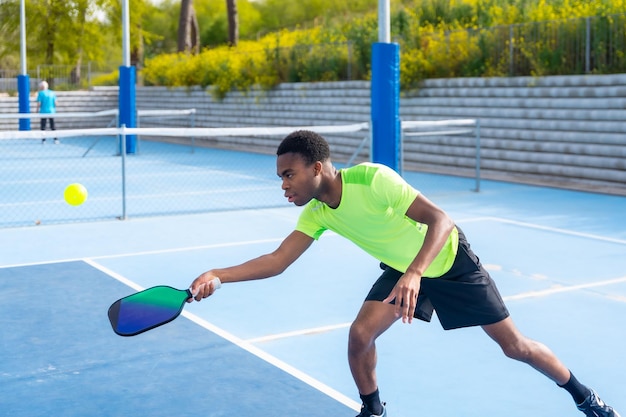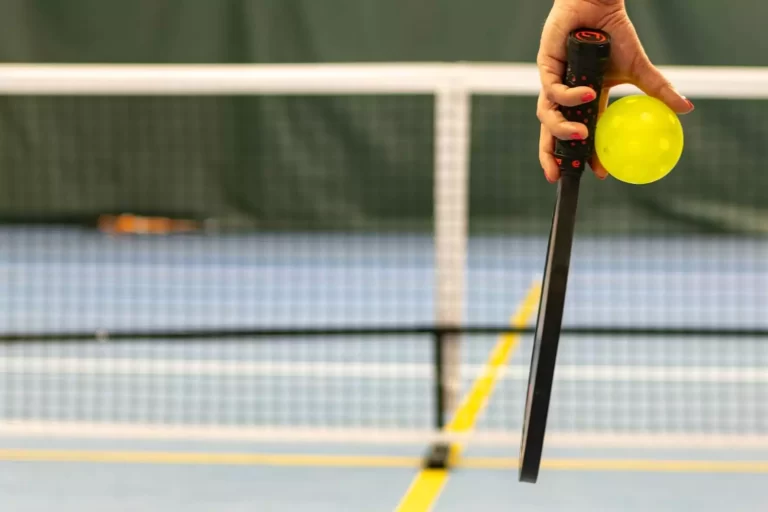Learn the rules about hitting the net in pickleball. Understand ‘let’ serves, accidental contact, and the consequences for your game.
So, you’ve nailed the dink shot, mastered the kitchen line battles, and now you’re eyeing up that net like it’s your worst enemy. But hang on – can you actually smack the net in pickleball, or is that an instant point for your opponent? Let’s untangle those net rules…
- The Golden Rule: Touching the net while the ball’s in play is a big no-no! (This includes your clothes, paddle, or any part of you). Think of it as pickleball’s version of “the floor is lava”.
- After the Strike: Once you’ve whacked the ball, you’re free to go a bit wild and cross over the net’s imaginary line if you don’t touch anything on the other side.
- The “Backspin Bounce” Exception: Get ready for a twist! If your opponent pulls off some wicked backspin and the ball bounces back over to your side, you can chase it down and even reach over the net to nail a return. Just don’t touch the net!
- Imagine you’re in the midst of an intense pickleball rally. The tension is palpable, your paddle grips tight in your hand, and then it happens: your shot grazes the net. But what’s next? Does the game pause, or do you play on? This pivotal moment can transform the game, and understanding the rules around net contact in pickleball is crucial for players at all levels.
As a seasoned pickleball enthusiast and an avid follower of the sport’s evolving rules, I’ve delved deep into the official guidelines and the unwritten laws that govern the play. Whether you’re a beginner trying to find your footing or a veteran aiming to refine your strategy, knowing the ins and outs of net contact can give you an edge.
- In the dynamic world of pickleball, every rule and regulation adds a layer to the strategy and excitement of the game. The rules surrounding net contact are no exception, providing both challenges and opportunities. Let’s dive into the specifics of net contact in pickleball, clearing up common misconceptions and shedding light on how this critical rule influences the flow of the game.

Is it allowed to hit the net during a pickleball game? (Core concept of net contact)
- Mostly no. Touching the net (or net posts) with your paddle, body, or clothing during a live rally is a fault.
- One exception: If the ball’s already bounced over the net and your momentum carries you into it, that’s okay.
What happens if the ball touches the net during play? (Essential rule clarification)
- Serve: If it hits the net but lands in the right spot, it’s a “let”. You get to serve again.
- Rally: If the ball hits the net during a rally and lands correctly on the other side, keep playing!
- Fault: If the ball hits the net then lands out of bounds or doesn’t go over, that’s a fault. Your opponent wins the point.
Can players intentionally use the net to their advantage? (Addresses strategic rule use)
- Nope! You can’t purposefully touch the net or net posts. It’s also not allowed to use the net to help you hit the ball over.
What are the consequences of hitting the net during a rally? (Key outcomes of net contact)
- Almost always a fault. This means you lose the point, and your opponent gets to serve.
Are there specific rules for net contact during serves? (Distinguishes net contact by situation)
- Yes! On a serve, a “let” happens if the ball hits the net, but lands in the right court. You get another chance to serve.
Is there a penalty for touching the net with the paddle or body? (Important rule on player contact)
- Yes. Touching the net or posts with your body or paddle, before the ball is dead, is a fault. You lose the point.
Where can players find official pickleball net contact regulations? (Resources for understanding the rules)
- The Official Rulebook of the USA Pickleball Association (USAPA). You’ll find it on their website.
How can players avoid net contact while maintaining aggressive play? (Practical tips for improvement)
- Footwork is key: Practice quick, precise footwork to get close to the net without crashing into it.
- Paddle control: Focus on keeping your paddle away from your body and in front of you.
What strategies can players use to minimize net contact? (Focus on reducing net contact)
- Aim high: Target shots slightly higher over the net to give yourself more safety margin.
- Watch the ball: Don’t just swing! Keep your eyes on the ball to avoid hitting the net on accident.
Why is hitting the net treated differently on serves vs. rallies? (Explores nuance in the rules)
- Gives the server a fair chance. Serves are harder to return, so the ‘let’ rule helps with fairness.
How can players practice net-awareness skills during training? (Skill development)
- Drills: Set up cones or markers close to the net to practice approach shots with precision.
- Partner play: Have a partner hit shots close to the net that you must volley without making a fault.
What are the common misconceptions about net contact in pickleball? (Dispelling myths)
- Myth: You can’t touch the net EVER.
- Truth: You can touch it after the ball is dead or bounces over.
And there you have it! Net rules in pickleball are all about keeping things fair and avoiding mid-game collisions. Remember, stay nimble, avoid that tempting net, and let your skills do the talking. Happy pickling!
- We’ve journeyed through the critical aspects of net contact in pickleball, uncovering the nuances that can make or break a game. From the initial serve to the heat of a volley, understanding how and when net contact is permissible empowers players to navigate the game with confidence and strategic insight.
- Mastering the rules around net contact is just the beginning. Pickleball is a game of precision, strategy, and adaptability. I encourage you to take this knowledge to the court, experiment with your shots, and observe how these rules play out in real-time. The more you play, the more intuitive these guidelines will become, seamlessly integrating into your gameplay.
- The pickleball community thrives on shared knowledge and experiences. Whether you’re discussing the latest rule changes, sharing gameplay tips, or recounting an unforgettable match, your insights contribute to the collective wisdom of pickleball players worldwide. Let’s continue to grow together, supporting one another as we navigate the exciting nuances of this beloved sport.
